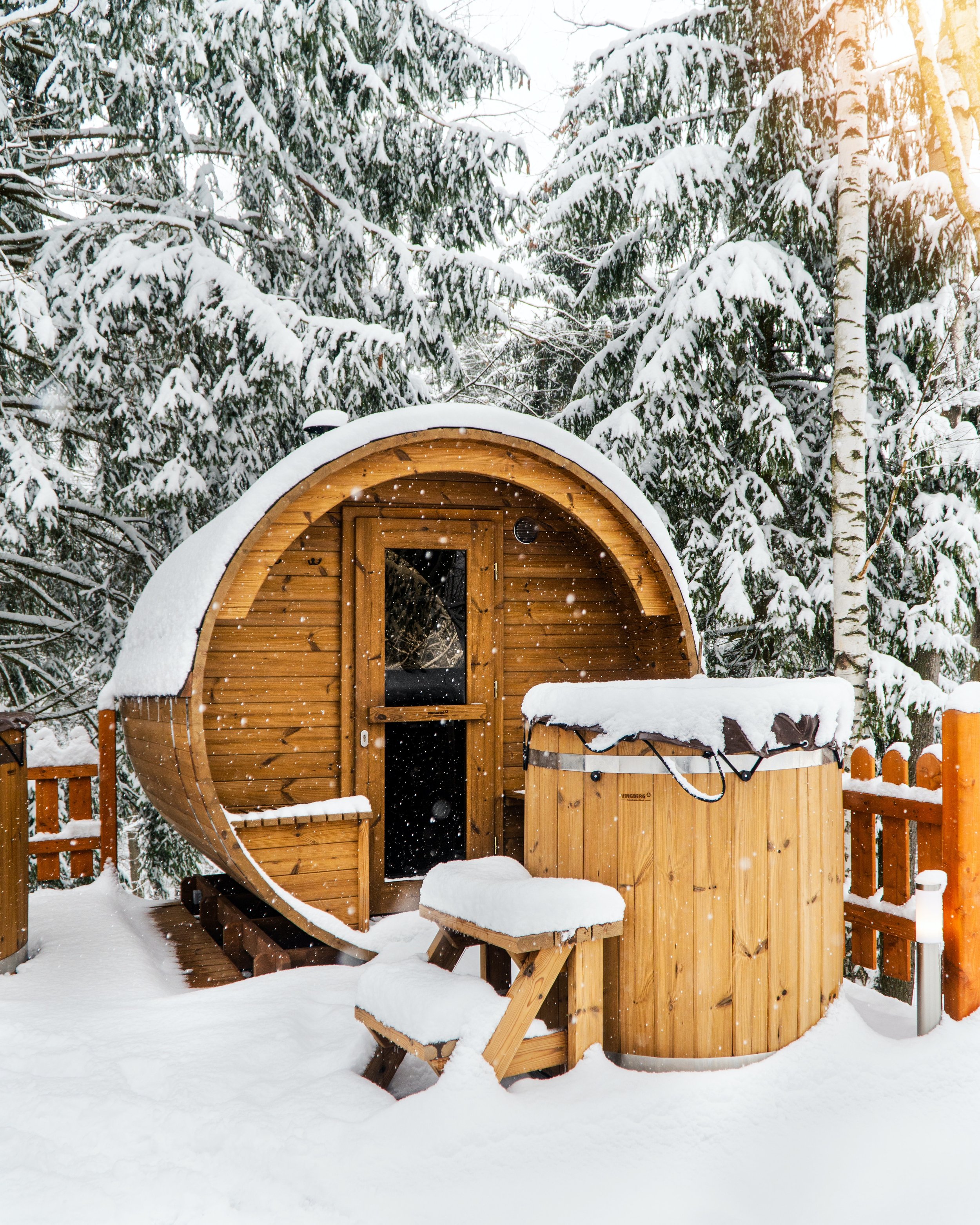Efficiency, Durability and Design: Comparing Hand-built, Kit and Barrel Saunas
If you’re looking to buy an outdoor sauna in the UK, it’s likely you’ll come across off-the-shelf kits from overseas manufacturers. Generally speaking, these come in two basic designs - a cabin-style with a pitched roof, and a barrel-shaped sauna. While barrel saunas in particular have a certain rustic charm, and easy-to-assemble kits are appealing, there are some important points to consider when choosing the right kind of structure for the environment.
The Importance of Heat Efficiency
One of the key features of a good sauna is heat efficiency. Heat efficiency saves time and energy, and has a huge impact on the associated costs of running a sauna. It also affects the sauna bathing experience - particularly in a wood-fired sauna - the more efficient, the less time is spent tending the fire to maintain the desired temperature and the more time spent relaxing. Keeping an inefficient sauna consistently hot enough to reap the physiological and psychological benefits can be very challenging (and sometimes constant work!), and as such the task can significantly detract from the experience.
Insulation is paramount to good heat efficiency, and this is something that unfortunately, single-walled kit saunas (including barrel saunas) lack. It’s notable that such saunas can still work relatively well in climates that experience more snowfall as the snow itself acts as insulation, but these designs do fall short in temperate regions, such as the UK and much of Europe.
Designed and handbuilt in the UK, our saunas are thoughtfully engineered to work efficiently in a variety of climates, including temperate, temperate-maritime, oceanic, and continental (cold). Each of our saunas has layered walls and ceiling to ensure maximum energy efficiency. From outside to inside there is: the external cladding (and/or metal sheeting), a breathable waterproof membrane, 100mm British sheep’s wool insulation, a unique vapour barrier, a ventilation layer and finally, the internal cladding. This means that the internal heat is much less affected by external conditions, and the sauna can reliably maintain high temperatures throughout all seasons.
An Arbor V in Wales in midwinter
Longevity and Climate
Another major aspect to consider with outdoor sauna design is the structure’s ability to withstand the weather conditions of its intended location. In temperate climates, and particularly in the UK, there is high rainfall and humidity, which can cause structures to deteriorate faster than in colder, drier environments.
Barrel saunas are built with a single wall made up of lengths of board with overlapping oval joints; this unfortunately means that leaks can occur between the boards when it rains, or when fallen snow begins to melt. In the winter months, a barrel sauna must be covered when not in use, or be situated beneath a second roof, to prevent the need for continuous maintenance.
Metal sheeting or shingle roofs are leak-proof and are much more resilient. While the timber of shingle roofs isn’t inherently waterproof, the angle of the pitch can make sure that water drains from the roof effectively. A waterproof membrane beneath the external materials ensures water is prevented from entering the sauna even in very stormy weather.
It’s also worth noting, not all shingles are made equal - while spruce and pine shingles may be appropriate for dry climates, in more humid environments, such as the UK, cedar is a far superior choice. Cedar is widely regarded as one of the most durable timbers for outdoor structures due to its high resin content. Known for its natural resilience against moisture, decay and insect damage, cedar will not bow or sag in response to high rainfall, and will last a lot longer.
For the internal walls and benches of a sauna, it’s important to use knot-free timber, such as the thermally modified poplar and ash we use. This is because knots cause weaknesses in the wood which can become problematic in an environment where temperatures and humidity rise and fall causing the timber to expand and contract. Bear in mind, temperature differences are exaggerated dramatically in barrel saunas that lack insulation, so if you are considering a barrel sauna, it’s a good idea to check with the manufacturer that the wood used is knot-free.
But longevity is determined by more than just the timber used. In addition to selecting appropriate timber species for each part of the sauna, the rigid galvanised steel base and stainless steel fixings we use in our saunas will withstand corrosion (such as from salty winds in coastal locations), so no part of the structure should show signs of wear for very many years.
An Arbor X Sauna, with insulated walls and pitched roof, in a frosty garden in the UK
A Barrel style sauna in the climate it’s designed for - places with drier seasons and heavy snowfall in winter for insulation.
How Design Shapes the Sauna Experience
The sauna’s design and materials are integral to the sauna bathing experience. In a barrel sauna, the enclosed, curved walls to some, feel protective and comforting, but to others, can feel claustrophobic and stifling, really, this comes down to individual preference. However, it’s certainly true that a greater range of positions and motion is possible in a pitched or flat roofed sauna, with straight walls allowing for multiple bench tiers, offering a greater temperature range and ample headroom too. In barrel saunas, there’s only room for one bench tier, and headroom is seriously limited!
Barrel saunas usually include two benches, facing each other, making them ideal for social sauna sessions. Although it is possible to install windows at the smaller, circular ends of the sauna, for the most part, you would be facing a fellow sauna bather or the curved timbers of the space. Overall, the experience is more intimate, social and -for want of a better word- cocoon-like.
In a straight-sided sauna, there’s a lot more flexibility in design, so how intimate or open it can feel is very variable. Inward facing benches can promote social connection (as in the Vapor), whereas tiered directional benches (as seen in the Aire+) offer privacy and different temperature options, again, which is best is down to personal preference. Larger glazing elements are possible, which can offer a view into surroundings, adding another dimension to the experience - one of connection with the natural world. A view into nature can enhance the psychological and physiological benefits of sauna bathing, and, in our experience, the sense of expansiveness created balances the intensity of the heat.
Opposite benches make the Vapor ideal for social sauna sessions
The Aire+ offers an uninterrupted view into nature
Crafting Quality Saunas From Scratch - Why We Don’t Make Kits
Our saunas are usually built as whole structures in our workshop, and transported fully-built to site. If this isn’t possible, we build the sauna in-situ. Building in this way means that the saunas are constructed layer by layer, so both the breathable waterproof membrane, and the vapour barrier wraps around every corner, so we can avoid any gaps where walls are joined.
With kit saunas, even if the external walls are insulated and protected by a breathable membrane, weaknesses can occur where the walls are joined together which can potentially pose a significant threat to the sauna’s longevity and weather resistance.
Aside from this, it does affect the finish, particularly internally. Building a sauna layer by layer, we are able to create striking design features such as fanned corner bench seats, and we can match up internal cladding from wall to wall seamlessly, creating a natural, flowing feel to the space. Furthermore, the way our benches are designed and built offers maximum strength and stability that simply couldn’t be achieved in a kit format. If we were to attempt to create a kit version of one of our saunas, many of the key design features which make our saunas unique would be lost.

















